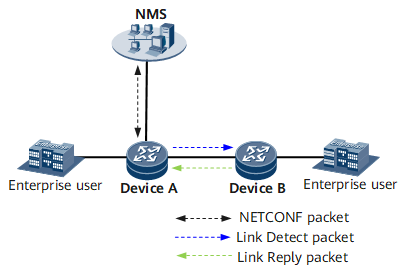Implementation
Background
To monitor the network status in real-time and to obtain detailed
network topology and changes in the topology, network administrators
usually deploy the Link Layer Discovery Protocol (LLDP) on live networks.
LLDP, however, has limited applications due to the following characteristics:
- LLDP uniquely identifies a device by its IP address. IP addresses are expressed in dotted decimal notation and therefore are not easy to maintain or manage, when compared with NE IDs that are expressed in decimal integers.
- LLDP is not supported on Ethernet sub-interfaces, Eth-Trunk interfaces, or low-speed interfaces, and therefore cannot discover neighbors for these types of interfaces.
- LLDP-enabled devices periodically broadcast LLDP packets, consuming many system resources and even affecting the transmission of user services.
Link Automatic Discovery (LAD) addresses the preceding
problems and is more flexible:
- LAD uniquely identifies a device by an NE ID in decimal integers, which are easier to maintain and manage.
- LAD can discover neighbors for various types of interfaces and therefore are more widely used than LLDP.
- LAD is triggered by an NMS or command lines and therefore can be implemented as you need.
Implementation
The following example uses the networking in Figure 1 to illustrate how LAD
is implemented.
The LAD implementation is as follows:
- DeviceA determines the interface type, encapsulates local information into a Link Detect packet, and sends the packet to DeviceB.
- After DeviceB receives the link Detect packet, DeviceB parses the packet and encapsulates local information and DeviceA's information carried in the packet into a Link Reply packet, and sends the Link Reply packet to DeviceA.
After DeviceA receives the Link Reply packet, DeviceA parses the packet and saves local information and DeviceB's information carried in the packet to the local MIB. The local and neighbor information is recorded as one entry.
 Local and remote devices exchange LAD packets to learn each other's NE ID, slot ID, subcard ID, interface number, and even each other's VLAN ID if sub-interfaces are used.
Local and remote devices exchange LAD packets to learn each other's NE ID, slot ID, subcard ID, interface number, and even each other's VLAN ID if sub-interfaces are used.- The NMS exchanges NETCONF packets with DeviceA to obtain DeviceA's local and neighbor information and then generates the topology of the entire network.
Benefits
After network administrators deploy LAD on devices, they can obtain information about all links connected to the devices. LAD helps extend the network management scale. Network administrators can obtain detailed network topology information and topology changes.
